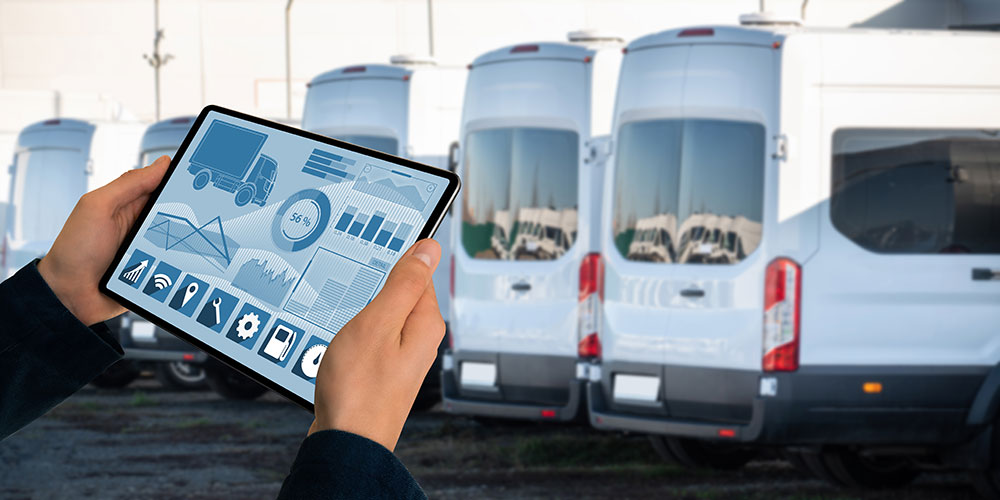Fleet Management: Creating an Inclusive Campus Through Accessible Transportation
Fleet Management: Creating an Inclusive Campus Through ... Campus Safety Magazine


Universities and Equal Opportunities for Students with Disabilities

Universities have a unique — and impactful — responsibility to ensure equal opportunities for all students, including those with disabilities. Universities can demonstrate a commitment to creating an inclusive environment by eliminating barriers that might hinder students with disabilities from fully participating in campus life, such as a lack of accessible transportation.
By implementing or improving accessible transportation options, universities can empower students with mobility challenges to successfully navigate the campus more easily, ensuring they can attend classes, engage in extracurricular activities, and access campus facilities without hindrance.
The Importance of University Fleet Accessibility
For many students with mobility challenges, university transit systems are the main — and sometimes only — means of getting around campus for classes and extracurriculars. Universities can promote students’ independence and autonomy through the use of accessible transportation services. According to a University of Washington case study, however, accessible transportation services are often limited to office hours. For students with mobility issues who take night classes, this greatly impacts their ability to succeed in their higher education goals.
Transit scheduling isn’t the only obstacle for students with mobility challenges, though. Not all university fleets have the proper amount of accessible vehicles and supporting infrastructure to meet the demand for service. Incorporating such services as on-demand transportation, wheelchair-accessible shuttles, and adaptive vehicles, as well as implementing autonomous vehicles (AVs), allows students with mobility challenges to navigate the campus.
The freedom to travel independently not only enhances the overall university experience but also fosters essential life skills and confidence in navigating the world beyond academia.
7 Steps to Improve University Transit Accessibility
- Conducting an audit: A comprehensive fleet audit is an essential first step in understanding how accessible the fleet currently is. This process helps identify existing gaps in the fleet’s accessibility capabilities and surface opportunities for improvement. By taking full inventory of all fleet assets, universities can plan for future updates or upgrades to ensure the entire fleet aligns with accessibility standards and goals.
- Consulting with other organizations: Collaboration with disability services offices, student organizations, and transportation experts is crucial when assessing opportunities to better serve students with disabilities. These stakeholders can provide valuable insights into the specific needs and challenges faced by students with mobility challenges. Seeking guidance from accessibility specialists and consultants will ensure that the university fleet meets industry standards and complies with any applicable regulations.
- Investing in wheelchair-accessible vehicles: Integrating a sufficient number of wheelchair-accessible shuttles and adaptive vehicles plays a big part in fostering accessibility. These vehicles should be equipped with proper wheelchair securement systems, ramps, and other necessary features to ensure the smooth transportation of students with mobility challenges. It’s also important to perform regular asset inspections and adhere to preventative maintenance standards recommended by the manufacturer to ensure safety and proper functionality.
- Enhancing driver training programs: Comprehensive training for drivers on disability awareness, accessible transportation protocols, and passenger assistance techniques plays a key role in creating a welcoming and inclusive environment for students with mobility challenges. Proper training ensures that students with mobility challenges feel comfortable and supported during their transportation experience.
- Creating on-demand transit solutions: Making accessible transportation available on-demand can provide students with greater flexibility to get where they need to go and when. The University of South Carolina implemented such a program, which works similarly to a ride-share service. Dial-a-Ride-Transit (DART) “is an origin-to-destination, advance reservation, shared-ride transportation service that complements the fixed-route bus services. There are no restrictions on the purpose or frequency of reservations. […] A fleet of small buses provides DART service. Each is equipped with wheelchair lifts and can accommodate four wheelchairs.”
- Utilizing technology: Technology is a powerful tool in enhancing accessibility. Integrating mobile apps, scheduling platforms, and real-time tracking systems streamlines transportation services, making them more efficient and accessible. Leveraging technology can significantly improve the overall user experience for students with mobility challenges.
- Using a fleet management system: An integrated university fleet management software (FMS) streamlines the process of upfitting the fleet, tracking assets, and managing maintenance. By ensuring the fleet is in optimal condition and available for those who need it most, universities can deliver a reliable and accessible transportation service.
AV Adoption and Accessibility Considerations
The increasing availability of AV technology opens up new opportunities for university fleets to further enhance accessibility. According to On-demand microtransit and paratransit service using autonomous vehicles: Gaps and opportunities in accessibility policy, an article in the official journal of the World Conference on Transport Research Society, however, realizing this potential depends on collaboration between vehicle manufacturers, policymakers, and state and municipal agencies to accommodate the needs of individuals with mobility challenges at different stages of trip making. In short, it’s a long-term goal with long-lasting benefits.
The research in the journal article asserts that when looking into the use of AVs in
SDGs, Targets, and Indicators
SDGs Addressed or Connected to the Issues Highlighted in the Article:
- SDG 4: Quality Education
- SDG 9: Industry, Innovation, and Infrastructure
- SDG 11: Sustainable Cities and Communities
- SDG 17: Partnerships for the Goals
Specific Targets Under Those SDGs Based on the Article’s Content:
- SDG 4.5: By 2030, eliminate gender disparities in education and ensure equal access to all levels of education and vocational training for the vulnerable, including persons with disabilities.
- SDG 9.1: Develop quality, reliable, sustainable, and resilient infrastructure, including regional and transborder infrastructure, to support economic development and human well-being, with a focus on affordable and equitable access for all.
- SDG 9.4: By 2030, upgrade infrastructure and retrofit industries to make them sustainable, with increased resource-use efficiency and greater adoption of clean and environmentally sound technologies and industrial processes.
- SDG 11.2: By 2030, provide access to safe, affordable, accessible, and sustainable transport systems for all, improving road safety, notably by expanding public transport, with special attention to the needs of those in vulnerable situations, women, children, persons with disabilities, and older persons.
- SDG 17.17: Encourage and promote effective public, public-private, and civil society partnerships, building on the experience and resourcing strategies of partnerships.
Indicators Mentioned or Implied in the Article:
- Indicator 4.5.1: Parity indices (female/male, rural/urban, bottom/top wealth quintile, and others such as disability status, indigenous peoples, and conflict-affected, as data become available) for all education indicators on access, participation, and completion.
- Indicator 9.1.1: Proportion of the rural population who live within 2 km of an all-season road.
- Indicator 9.4.1: CO2 emission per unit of value added.
- Indicator 11.2.1: Proportion of population that has convenient access to public transport, by sex, age, and persons with disabilities.
- Indicator 17.17.1: Amount of United States dollars committed to public-private partnerships.
Table: SDGs, Targets, and Indicators
| SDGs | Targets | Indicators |
|---|---|---|
| SDG 4: Quality Education | 4.5: By 2030, eliminate gender disparities in education and ensure equal access to all levels of education and vocational training for the vulnerable, including persons with disabilities. | 4.5.1: Parity indices (female/male, rural/urban, bottom/top wealth quintile, and others such as disability status, indigenous peoples, and conflict-affected, as data become available) for all education indicators on access, participation, and completion. |
| SDG 9: Industry, Innovation, and Infrastructure | 9.1: Develop quality, reliable, sustainable, and resilient infrastructure, including regional and transborder infrastructure, to support economic development and human well-being, with a focus on affordable and equitable access for all. | 9.1.1: Proportion of the rural population who live within 2 km of an all-season road. |
| SDG 9: Industry, Innovation, and Infrastructure | 9.4: By 2030, upgrade infrastructure and retrofit industries to make them sustainable, with increased resource-use efficiency and greater adoption of clean and environmentally sound technologies and industrial processes. | 9.4.1: CO2 emission per unit of value added. |
| SDG 11: Sustainable Cities and Communities | 11.2: By 2030, provide access to safe, affordable, accessible, and sustainable transport systems for all, improving road safety, notably by expanding public transport, with special attention to the needs of those in vulnerable situations, women, children, persons with disabilities, and older persons. | 11.2.1: Proportion of population that has convenient access to public transport, by sex, age, and persons with disabilities. |
| SDG 17: Partnerships for the Goals | 17.17: Encourage and promote effective public, public-private, and civil society partnerships, building on the experience and resourcing strategies of partnerships. | 17.17.1: Amount of United States dollars committed to public-private partnerships. |
Behold! This splendid article springs forth from the wellspring of knowledge, shaped by a wondrous proprietary AI technology that delved into a vast ocean of data, illuminating the path towards the Sustainable Development Goals. Remember that all rights are reserved by SDG Investors LLC, empowering us to champion progress together.
Source: campussafetymagazine.com

Join us, as fellow seekers of change, on a transformative journey at https://sdgtalks.ai/welcome, where you can become a member and actively contribute to shaping a brighter future.







